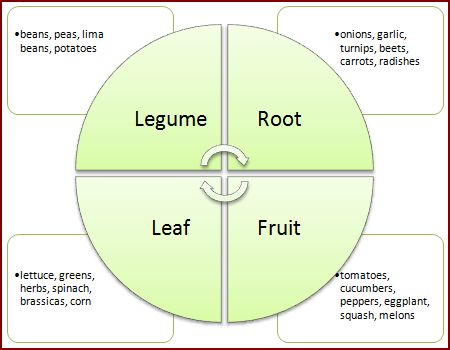Why and how to rotate your crops for healthier gardens

Rotating garden crops is one of the most basic techniques gardeners, homesteaders, and farmers can use to assure plant crop success. Everyone should consider rotating their crops, because it helps maximize Garden Crop Rotationproductivity while minimizing pests and disease. The practice of rotating crops can be simple or complex – I like this system because it’s simple and easy to follow year after year.
What Is It
Farmers have been rotating crops since farming began, and there are many different strategies. In effect, you’re just making sure that when the bugs and diseases that like tomatoes wake up in the bed you grew tomatoes in last year, there aren’t tomatoes there for them to conveniently feast on this year. Instead, perhaps they’ll find carrots which they don’t happen to like, and die trying to find their way back to those tasty tomatoes.
How It Works (Legume <- Leaf <- Fruit <- Root)
I like this system that breaks the various garden plants into four groups based on their nutritional needs: leaf (nitrogen), fruit (phosphorus), root (potassium), and legume (fixes nitrogen). In this system, the leaf plants go where legumes were last year, because legumes fix nitrogen in the soil, and leaf plants need large amounts of nitrogen. The fruits follow the leaf plants because they need phosphorus, and too much nitrogen causes them not to have fruits. The roots follow the fruits because they need potassium and need nitrogen less than the fruits. Finally, the legumes follow the roots to put nitrogen back into the soil. Because this is a simple sequence, and it makes sense to me, I can remember how it goes each year.

The Leaf Group
The leaf group contains all the big nitrogen dependent crops like lettuce, greens, herbs, spinach, and the brassicas (cabbage, broccoli, cauliflower, brussel sprouts, and kale). They need lots of nitrogen to grow strong leaves and stems but nitrogen is the hardest nutrient to keep in the soil. That’s why they follow the nitrogen fixing legumes in the rotation.
The Fruit Group
The fruits include tomatoes, cucumbers, peppers, eggplant, and squash. These plants need phosphorus to set blossoms and develop fruit, but shouldn’t get lots of nitrogen or they’ll make all leaves and no fruit. Technically, corn is a fruiting crop but I grow it as an exception in the leaf group because it does need lots of nitrogen.
The Root Group
Onions, garlic, turnips, carrots, beets, and radishes are all root crops that need potassium but don’t need much nitrogen. So, the roots follow the fruits since there’s little nitrogen left at this point in the rotation. Potatoes are root crops but I plant them with the legumes. That’s because they’re members of the nightshade family and suffer from the same pests as tomatoes, peppers, and eggplant, so I don’t want them to follow the fruits. They seem to suffer a lot more pest damage when they do.
The Legume Group
Beans and peas are said to be nitrogen-fixing because they pull nitrogen from the air and store it in their roots. So they follow the roots and insure there’ll be lots of nitrogen available for the next leaf rotation.
That’s all there is to this simple crop rotation system, now I just need to get last year’s garden plan out and decide where everything will go this year. Wherever the peas and beans were last year, that’s where this year’s leafy vegetables will go, wherever the leafy crops were, that’s where the tomatoes will go, and so on. It actually makes planning the vegetable garden pretty simple.
Simple crop rotation

No comments:
Post a Comment